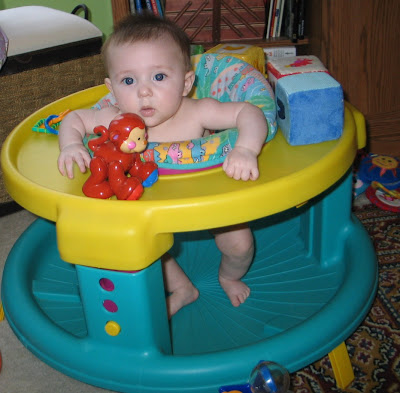Ripley Photos
Teresa has taken some great photos the last two weeks and I have finally found the time to put them on the blog. Special on the photos with the head bans; Ripley doesn't not wear them out of the house. We find them gay ; - ). There is a video of Ripley on her newest yard sale find. You have to love the yard sales.
Sunday, April 25, 2010
Wednesday, April 21, 2010
I Saw the Sign
The Apostle John recorded several of Jesus’ signs in order to develop the faith of his readers (John 20:30-31; Therefore many other signs Jesus also performed in the presence of the disciples, which are not written in this book; but these have been written so that you may believe that Jesus is the Christ, the Son of God; and that believing you may have life in His name.).
There are a total 7 signs that John recorded in his gospel. They are:
1. The changing the water into wine 2:1-11
2. The temple cleansing 2:13-22
3. The healing of the nobleman’s son 4:46-54
4. The healing of the lame man 5:1-15
5. The feeding of the multitude 6:1-15
6. The healing of the blind man 9:1-41
7. The raising of Lazarus from the dead 11:1-44
John does not use the word miracle to describe what Jesus does as the other gospels do. John’s purpose is different than the other gospels. John consistently refers to Jesus’ mighty works as “signs;” the Greek word semeion (say-mi'-on). A miracle underscores power and is generally received with awe. A sign reveals something from God; something that was once hidden.
The signs are not merely acts of power and might, they reveal that God is at work in Jesus and is present in Him. All of Jesus’ signs were done in the first half of the Gospel of John which we refer to as “Jesus’ public ministry.” While Jesus’ disciples see in Jesus’ signs a reflection of the glory of God, the very same signs reveal the hardening of the Jewish leadership in its rejection of Israel’s Messiah.
The two events showed in John chapter 2 shows Jesus as the restorer of Israel. Jesus is shown to fill up the depleted resources of Judaism when He turned the water into wine. And in cleansing the temple, Jesus is shown as being the restorer of the true worship of Israel and the replacement of the temple in the life of God's people.
Jesus just didn't come to the festivals; He came to fulfill their true meaning. He came to end them and replace them with Himself. In each episode, similar themes challenge us, and we are invited to contrast them. Cana offered stone jars (for purification) and now Jesus has challenged a stone temple (for sacrifice). Cana was out of wine and the temple was filled with the wrong thing. Jesus' solution in each case is to provide an alternative: He will be the giver of new wine and will become the new temple. Galilee and Jerusalem offer different responses to Jesus' work: In Galilee Jesus finds willing hearts and faith; but in Judea, while some believe, Jesus is suspicious. Throughout John's gospel, Galilee and Jerusalem play out as virtual metaphors of responses. Through them we are challenged to reflect on how we will respond too, should Jesus visit a wedding or a temple today.
The Apostle John recorded several of Jesus’ signs in order to develop the faith of his readers (John 20:30-31; Therefore many other signs Jesus also performed in the presence of the disciples, which are not written in this book; but these have been written so that you may believe that Jesus is the Christ, the Son of God; and that believing you may have life in His name.).
There are a total 7 signs that John recorded in his gospel. They are:
1. The changing the water into wine 2:1-11
2. The temple cleansing 2:13-22
3. The healing of the nobleman’s son 4:46-54
4. The healing of the lame man 5:1-15
5. The feeding of the multitude 6:1-15
6. The healing of the blind man 9:1-41
7. The raising of Lazarus from the dead 11:1-44
John does not use the word miracle to describe what Jesus does as the other gospels do. John’s purpose is different than the other gospels. John consistently refers to Jesus’ mighty works as “signs;” the Greek word semeion (say-mi'-on). A miracle underscores power and is generally received with awe. A sign reveals something from God; something that was once hidden.
The signs are not merely acts of power and might, they reveal that God is at work in Jesus and is present in Him. All of Jesus’ signs were done in the first half of the Gospel of John which we refer to as “Jesus’ public ministry.” While Jesus’ disciples see in Jesus’ signs a reflection of the glory of God, the very same signs reveal the hardening of the Jewish leadership in its rejection of Israel’s Messiah.
The two events showed in John chapter 2 shows Jesus as the restorer of Israel. Jesus is shown to fill up the depleted resources of Judaism when He turned the water into wine. And in cleansing the temple, Jesus is shown as being the restorer of the true worship of Israel and the replacement of the temple in the life of God's people.
Jesus just didn't come to the festivals; He came to fulfill their true meaning. He came to end them and replace them with Himself. In each episode, similar themes challenge us, and we are invited to contrast them. Cana offered stone jars (for purification) and now Jesus has challenged a stone temple (for sacrifice). Cana was out of wine and the temple was filled with the wrong thing. Jesus' solution in each case is to provide an alternative: He will be the giver of new wine and will become the new temple. Galilee and Jerusalem offer different responses to Jesus' work: In Galilee Jesus finds willing hearts and faith; but in Judea, while some believe, Jesus is suspicious. Throughout John's gospel, Galilee and Jerusalem play out as virtual metaphors of responses. Through them we are challenged to reflect on how we will respond too, should Jesus visit a wedding or a temple today.
Tuesday, April 20, 2010
Our Little Pterodactyl

It’s been awhile since my last posting; it’s been somewhat busy with my duties at Common Ground and working but I wanted to share a cute little thing about Ripley. She has discovered her voice. She is starting to shriek and the happier she is the higher the pitch. We are starting to say we have a pterodactyl in the house.
This morning Teresa called me and told me that we have an invasion of pterodactyls in the house. Ripley has just been shriek for almost 5 minutes straight trying to talk with her Mommy. When Teresa called me, Ripley stopped. Ripley really wants to talk about she moves her little lip when we talk with her and nothing is coming out other then her inner pterodactyl.
I’m starting to think that since she is part Irish, she has a banshee inside trying to get out. It’s all part of her learning and it is very neat to watch. We will remember these things late very fondly; even when it means hearing her shriek at 3 o’clock in the morning. It’s all good.

It’s been awhile since my last posting; it’s been somewhat busy with my duties at Common Ground and working but I wanted to share a cute little thing about Ripley. She has discovered her voice. She is starting to shriek and the happier she is the higher the pitch. We are starting to say we have a pterodactyl in the house.
This morning Teresa called me and told me that we have an invasion of pterodactyls in the house. Ripley has just been shriek for almost 5 minutes straight trying to talk with her Mommy. When Teresa called me, Ripley stopped. Ripley really wants to talk about she moves her little lip when we talk with her and nothing is coming out other then her inner pterodactyl.
I’m starting to think that since she is part Irish, she has a banshee inside trying to get out. It’s all part of her learning and it is very neat to watch. We will remember these things late very fondly; even when it means hearing her shriek at 3 o’clock in the morning. It’s all good.
Sunday, April 04, 2010
Friday, April 02, 2010
Thursday, April 01, 2010
April 1st

It’s hard to believe it’s April already. When I think of April, green grass, flowers, and little children running around playing comes to my mind. Another thing that comes to me is that today’s Teresa’s spiritual birthday. Today 14 years ago, Teresa accepted Christ as her Savior.
For other people, they see today as “April Fool’s Day.” Some time ago, I looked into the history of today because I wanted to know why April 1st has this on it. Below is a brief history of April 1st.
The history of April Fool's Day or All Fool's Day is uncertain, but the current thinking is that it began around 1582 in France with the reform of the calendar under Charles IX. The Gregorian Calendar was introduced, and New Year's Day was moved from March 25 - April 1 (new year's week) to January 1.
Communication traveled slowly in those days and some people were only informed of the change several years later. Still others, who were more rebellious refused to acknowledge the change and continued to celebrate on the last day of the former celebration, April 1.
These people were labeled "fools" by the general populace, were subject to ridicule and sent on "fool errands," sent invitations to nonexistent parties and had other practical jokes played upon them. The butts of these pranks became known as a "poisson d'avril" or "April fish" because a young naive fish is easily caught. In addition, one common practice was to hook a paper fish on the back of someone as a joke.
This harassment evolved over time and a custom of prank-playing continue on the first day of April. This tradition eventually spread elsewhere like to Britain and Scotland in the 18th century and was introduced to the American colonies by the English and the French. Because of this spread to other countries, April Fool's Day has taken on an international flavor with each country celebrating the holiday in its own way.
In Scotland, for instance, April Fool's Day is devoted to spoofs involving the buttocks and as such is called Taily Day. The butts of these jokes are known as April 'Gowk', another name for cuckoo bird. The origins of the "Kick Me" sign can be traced back to the Scottish observance.
In England, jokes are played only in the morning. Fools are called 'gobs' or 'gobby' and the victim of a joke is called a 'noodle.' It was considered bad luck to play a practical joke on someone after noon.

It’s hard to believe it’s April already. When I think of April, green grass, flowers, and little children running around playing comes to my mind. Another thing that comes to me is that today’s Teresa’s spiritual birthday. Today 14 years ago, Teresa accepted Christ as her Savior.
For other people, they see today as “April Fool’s Day.” Some time ago, I looked into the history of today because I wanted to know why April 1st has this on it. Below is a brief history of April 1st.
The history of April Fool's Day or All Fool's Day is uncertain, but the current thinking is that it began around 1582 in France with the reform of the calendar under Charles IX. The Gregorian Calendar was introduced, and New Year's Day was moved from March 25 - April 1 (new year's week) to January 1.
Communication traveled slowly in those days and some people were only informed of the change several years later. Still others, who were more rebellious refused to acknowledge the change and continued to celebrate on the last day of the former celebration, April 1.
These people were labeled "fools" by the general populace, were subject to ridicule and sent on "fool errands," sent invitations to nonexistent parties and had other practical jokes played upon them. The butts of these pranks became known as a "poisson d'avril" or "April fish" because a young naive fish is easily caught. In addition, one common practice was to hook a paper fish on the back of someone as a joke.
This harassment evolved over time and a custom of prank-playing continue on the first day of April. This tradition eventually spread elsewhere like to Britain and Scotland in the 18th century and was introduced to the American colonies by the English and the French. Because of this spread to other countries, April Fool's Day has taken on an international flavor with each country celebrating the holiday in its own way.
In Scotland, for instance, April Fool's Day is devoted to spoofs involving the buttocks and as such is called Taily Day. The butts of these jokes are known as April 'Gowk', another name for cuckoo bird. The origins of the "Kick Me" sign can be traced back to the Scottish observance.
In England, jokes are played only in the morning. Fools are called 'gobs' or 'gobby' and the victim of a joke is called a 'noodle.' It was considered bad luck to play a practical joke on someone after noon.
Subscribe to:
Posts (Atom)

.JPG)
.JPG)











.JPG)
.JPG)
.JPG)
.JPG)
.JPG)
.JPG)
.JPG)
.JPG)
.JPG)
.JPG)
.JPG)


.JPG)








